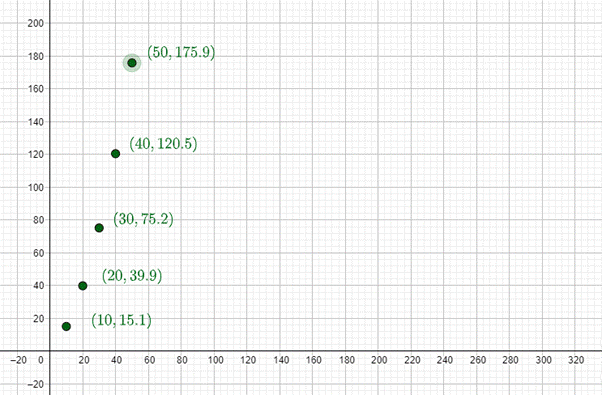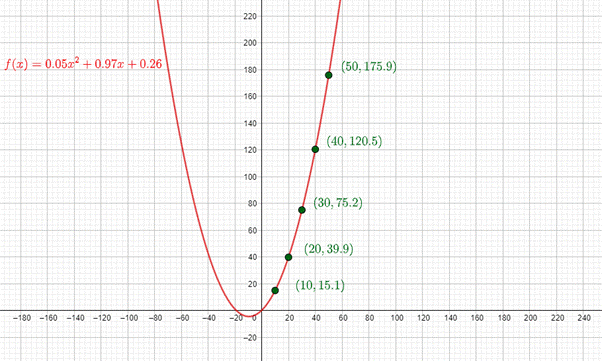
Concept explainers
a)
To draw a
Given the data:
| Speed | Stopping Distance |
| 10 | 15.1 |
| 20 | 39.9 |
| 30 | 75.2 |
| 40 | 120.5 |
| 50 | 175.9 |
Draw a scatter plot of the data:

The speed is represented along the
b)
To find a quadratic regression model of the data.
The quadratic curve that best fits the data:
Given the data:
| Speed | Stopping Distance |
| 10 | 15.1 |
| 20 | 39.9 |
| 30 | 75.2 |
| 40 | 120.5 |
| 50 | 175.9 |
A calculator is used to find a quadratic curve that best fits the data:
The equation of the curve is found:
Conclusion:
The quadratic curve that best fits the data:
c)
Superimpose the regression curve, found in the previous part, in the scatter plot.

The regression curve
d)
To use the regression model to find the stopping distance of a vehicle travelling at a speed of
As per the regression model, the stopping distance of the vehicle travelling at a speed of
Found the regression mode:
Substitute
Thus,
Conclusion:
As per the regression model, the stopping distance of the vehicle travelling at a speed of
e)
To determine the speed predicted by the regression model when the stopping distance is
As per the regression model, the stopping distance of the vehicle will be
Found the regression model:
Substitute
Solve the equation
Conclusion:
Thus,
That is, as per the regression model, the stopping distance of the vehicle will be
Chapter 2 Solutions
PRECALCULUS:GRAPH...-NASTA ED.(FLORIDA)
- Pls help ASAParrow_forward9. a) Determie values of a and b so that the function is continuous. ax - 2b f(x) 2 x≤-2 -2x+a, x ≥2 \-ax² - bx + 1, −2 < x < 2) 9b) Consider f(x): = 2x²+x-3 x-b and determine all the values of b such that f(x) does not have a vertical asymptote. Show work.arrow_forwardPls help ASAParrow_forward
- 3. True False. If false create functions that prove it is false. Note: f(x) = g(x). a) If_lim ƒ(x) = ∞ and_lim g(x) = ∞,then_lim [ƒ(x) − g(x)] = 0 x→ 0+ x→0+ x→0+ b) If h(x) and g(x) are continuous at x = c, and if h(c) > 0 and g(c) = 0, then h(x) lim. will = x→c g(x) c) If lim f(x) = 0 and lim g(x) = 0 then lim f(x) does not exist. x-a x-a x→a g(x)arrow_forwardPls help ASAParrow_forward15. a) Consider f(x) = x-1 3x+2 and use the difference quotient to determine the simplified expression in terms of x, for the slope of any tangent to y = f(x). Also, determine the slope at x = 2. 15 b) Determine the equation of the tangent to f(x) at x = 2. Final answer in Standard Form Ax + By + C = 0, A ≥ 0, with no fractions or decimals.arrow_forward
 Calculus: Early TranscendentalsCalculusISBN:9781285741550Author:James StewartPublisher:Cengage Learning
Calculus: Early TranscendentalsCalculusISBN:9781285741550Author:James StewartPublisher:Cengage Learning Thomas' Calculus (14th Edition)CalculusISBN:9780134438986Author:Joel R. Hass, Christopher E. Heil, Maurice D. WeirPublisher:PEARSON
Thomas' Calculus (14th Edition)CalculusISBN:9780134438986Author:Joel R. Hass, Christopher E. Heil, Maurice D. WeirPublisher:PEARSON Calculus: Early Transcendentals (3rd Edition)CalculusISBN:9780134763644Author:William L. Briggs, Lyle Cochran, Bernard Gillett, Eric SchulzPublisher:PEARSON
Calculus: Early Transcendentals (3rd Edition)CalculusISBN:9780134763644Author:William L. Briggs, Lyle Cochran, Bernard Gillett, Eric SchulzPublisher:PEARSON Calculus: Early TranscendentalsCalculusISBN:9781319050740Author:Jon Rogawski, Colin Adams, Robert FranzosaPublisher:W. H. Freeman
Calculus: Early TranscendentalsCalculusISBN:9781319050740Author:Jon Rogawski, Colin Adams, Robert FranzosaPublisher:W. H. Freeman
 Calculus: Early Transcendental FunctionsCalculusISBN:9781337552516Author:Ron Larson, Bruce H. EdwardsPublisher:Cengage Learning
Calculus: Early Transcendental FunctionsCalculusISBN:9781337552516Author:Ron Larson, Bruce H. EdwardsPublisher:Cengage Learning





